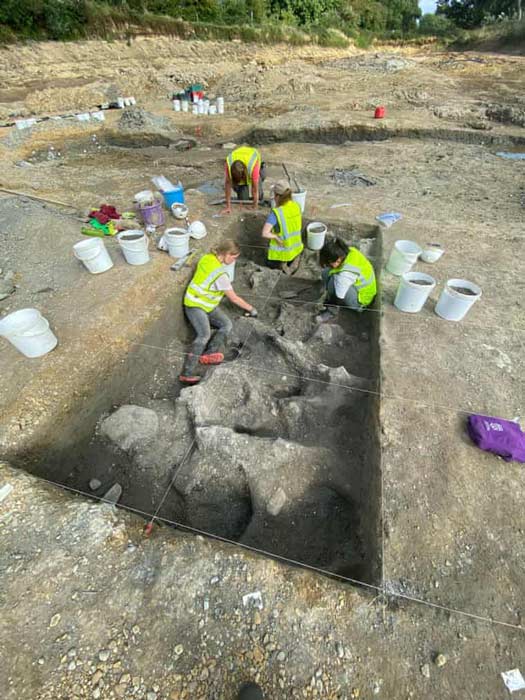
Neanderthal Hand Axe Leads to Steppe Mammoth Graveyard
Five ancient prehistoric Steppe mammoth skeletons have been unearthed in Britain. How did they get there, and how did they die? The deeply ancient Steppe mammoth site was discovered at a quarry near Swindon in England’s Cotswolds region, after fossil hunters Sally and Neville Hollingworth identified a Neanderthal hand axe. Now, archaeologists have unearthed five prehistoric Steppe mammoth skeletons where early hunters dined 215,000 years ago, including two adults, two juveniles and an infant. Archaeologists from DigVentures also discovered fragile beetle wings, freshwater snail shells, and stone tools from the Neanderthal age.
All of these discoveries will be explored in a new BBC One documentary starring Sir David Attenborough, “ Attenborough and the Mammoth Graveyard,” to be aired on 30 December 2021. This show will also feature evolutionary biologist, Professor Ben Garrod of the University of East Anglia, and archaeologists from the team at DigVentures, who will all help explain how the mammoths got there, and how their lives ended.

Hundreds of steppe mammoth bones have been found - tusks, teeth, leg bones, as well as stone tools, including a stone hand axe (right). (DigVentures)
Swindon’s Steppe Mammoth: Oldest Neanderthal Hunting Site?
In an article in The Guardian, Prof Garrod describes the site as archaeological “gold dust.” Furthermore, the discovery of the Neanderthal tool kit might mean the site was “a massive buffet” at a Neanderthal campsite. In the new documentary the scientists will ask if the Steppe mammoths had been chased into the mud and trapped, or whether the hunters found them there already “and got a free meal,” said Garrod.
Lisa Westcott Wilkins from DigVentures said in a press release that finding mammoth bones is always extraordinary. However, finding examples that are so old, and in this instance so well preserved, and in such close proximity to Neanderthal stone tools, “is exceptional.”
Steppe mammoths lived from approximately 1.8 million years ago to about 200,000 years ago. Therefore, if the cut-marks found on the bones are determined to have been made by hands, this site becomes the oldest scientifically excavated Neanderthal butchering site for mammoths in all of Britain.

Close inspection of the excavated steppe mammoth bones, some of which have possible butchery marks. (DigVentures)
The Most Significant Ice Age Discovery In Recent Years
Ms Hollingworth told the BBC that the team of researchers were originally hoping to find marine fossils, “and finding something so significant instead has been a real thrill.” “Even better,” said Hollingworth, is seeing the discovery site being converted into a major archaeological excavation. But why so many mammoths were found in this one location, and whether they were hunted or scavenged by Neanderthals, is yet unknown.
Imagine having spent several summers on your hands and knees in a wet ditch carefully scraping around ancient Neanderthal tools. Then, one afternoon, a massive mammoth tusk emerges from the soil beneath you, and you realize you are standing on the remains of a monster from the last Ice Age. Duncan Wilson, chief Executive of Historic England, said the site represents “one of Britain's most significant Ice Age discoveries in recent years.”

Archaeologists excavating the Steppe mammoth bones at the Swindon site. (DigVentures)
Climate Change Did The Dirty Work, Not Us
Duncan Wilson told the UK press that the findings “have enormous value for understanding the human occupation of Britain.” Furthermore, what he describes as “delicate environmental evidence” is also expected to better illustrate the context of past “climate change.” For five million years, mammoths roamed the Earth before vanishing for good nearly 4,000 years ago. And until eight weeks ago nobody knew why this happened.
A paper published this October in the journal Nature, by Professor Eske Willerslev, a fellow at St John's College, University of Cambridge, demonstrated how mammoth skeletons were traditionally used to build shelters, and that harpoons were carved from their giant tusks. However, nobody was ever quite sure if human hunters actually drove the species to extinction. Now this long outstanding question has finally been answered.

An archaeologist carefully excavating a tusk at the Swindon site. (DigVentures)
Plant Changes Felled The Great Beasts In The End
Dr Willerslev and a team of geneticists analyzed ancient environmental DNA and discovered why mammoths went extinct. It was “because when the icebergs melted, it became far too wet for the giant animals to survive because their food source—vegetation—was practically wiped out.” As the climate warmed up, trees and wetland plants took over and replaced the mammoth's ancestral grassland habitats.
- The World’s First 'Mammoth Traps' Found in Mexico?
- Mexico City’s Mammoth Skeleton Site Grows to World’s Largest Find
Professor Willerslev said the study was a stark lesson from history, warning how unpredictable climate change can be. Thus, precipitation was the number one cause of the extinction of mammoths, which caused rapid changes in plant life. And this change happened so quickly that mammoths couldn’t adapt and evolve. Nothing is guaranteed when it comes to the impact of dramatic changes in the weather, said Professor Willerslev.
Top image: Sir David Attenborough with some of the Steppe mammoth bones found in the gravel quarry near Swindon. Source: Julian Schwanitz / BBC / Windfall Films
By Ashley Cowie















